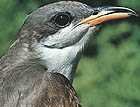Cuckoo among UK’s most threatened birds
One in five of the UK's bird species is now of 'highest conservation concern', a new report reveals


An alarming 52 species of birds are now on the UK’s conservation red list, including valued countryside birds such as the cuckoo, the lapwing and the yellow wagtail, and widespread species such as the turtle dove, the grey partridge, the house sparrow and the starling.
The Birds of Conservation Concern 3 shows that more than one in five (21%) of the UK’s 246 regularly occurring bird species are now of highest conservation concern, compared with 40 species (16%) in 2002.
There are 21 birds on the red list that are summer visitors to the UK, including the cuckoo, the wood warbler and the tree pipit. Their addition to the list suggests that many long-distance migratory birds nesting in Europe and wintering in Africa are now in danger.
Dr Mark Avery, the RSPB’s conservation director, says: ‘This is scandalous. When the RSPB was formed 120 years ago, few would have been concerned about the cuckoo, lapwing, starling or house sparrow. Now these birds are some of our greatest conservation priorities.
‘Most shocking is the more recently observed and drastic decline of summer-visiting birds, typified by the cuckoo.’
Andy Clements, director of the British Trust for Ornithology (BTO), adds: ‘A gap all of us will notice is the lack of the cuckoo’s familiar song, their decline emblematic of downward trends in long-distance migrants from Africa. That is why BTO and our partners are working together, targeting research at understanding why migrant birds are in decline.’
Three seabird species are also new to the red list, including the Balearic shearwater, which is thought to face a higher risk of global extinction than the giant panda, the herring gull, whose population has more than halved in recent times, and the Arctic skua, which highlights concerns about fortunes of seabirds around the northern coasts of the British Isles.
Exquisite houses, the beauty of Nature, and how to get the most from your life, straight to your inbox.
However, six species have been removed from the red list. The fortunes of the stone-curlew, which is mainly confined to the South-West, have dramatically improved thanks to a concerted effort by landowners. Improvements in land management, especially of heathland, have also led to an increase in the population of the woodlark.
Dr Avery says: ‘Conservation works, but with a growing to-do list, we have to strive even harder to retain the rich variety of wildlife that our islands possess.’
The Birds of Conservation 3 report is compiled by a number of organisations, including the BTO, Countryside Council for Wales, Game & Wildlife Conservation Trust, Joint Nature Conservation Committee, Natural England, Northern Ireland Environment Agency, the RSPB, Scottish Natural Heritage, and the Wildfowl & Wetlands Trust. The full report will be published in the June edition of British Birds.
To comment on this article, use the comment box below, or email us at clonews@ipcmedia.com. Read more about the countryside
For more news stories like this every week subscribe to Country Life
Country Life is unlike any other magazine: the only glossy weekly on the newsstand and the only magazine that has been guest-edited by His Majesty The King not once, but twice. It is a celebration of modern rural life and all its diverse joys and pleasures — that was first published in Queen Victoria's Diamond Jubilee year. Our eclectic mixture of witty and informative content — from the most up-to-date property news and commentary and a coveted glimpse inside some of the UK's best houses and gardens, to gardening, the arts and interior design, written by experts in their field — still cannot be found in print or online, anywhere else.
